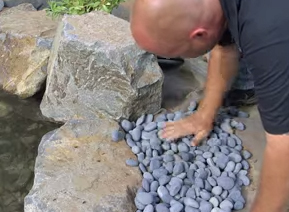Developing an Edge

As I mention at the start of this video, setting the edges is just about my favorite part of the pond-installation process. As is true with juggling and placing big rocks, there’s an art to getting things just right and making the setting look as natural as possible – that is, as though the pond not only belongs there but has also been there for uncounted years..
As the video discusses, there are lots of possible approaches and obvious value in using a mixture of rock sizes, materials and blends to get the job done. Just as with swimming pools, there’s nothing more deadly visually than the “string of pearls” look: Without question, it makes a pond seem out of place and unnatural – a careless look I avoid at all costs!
As I work on the edges, my goal is to make them varied – and to soften them wherever it makes sense with carefully placed plants, both within and outside the water. Another key to a naturalistic look is to make certain boulders you work with at the edges and moving back into the landscape are imbedded in the ground rather than plopped onto the surface.
Two points: One, dig with care around the pond’s edges. You don’t want to cause a leak with a carelessly driven shovel blade. Two – and much more important – get out into nature and visit streams, waterfalls and ponds in your local area to see how things look where you and your clients live and hike. What you see will inspire and refine your work on pond edges and with landscape stone. It’s also undeniable that some time away from daily cares will do your head some good, even if this time spent studying the natural world might be called homework!
To see a range of edge-treatment options and possibilities, click here.
Eric Triplett is founder and chief executive officer at The Pond Digger Waterscape Design & Construction in Yucaipa, Calif. He may be reached at eric@the ponddigger.com.










